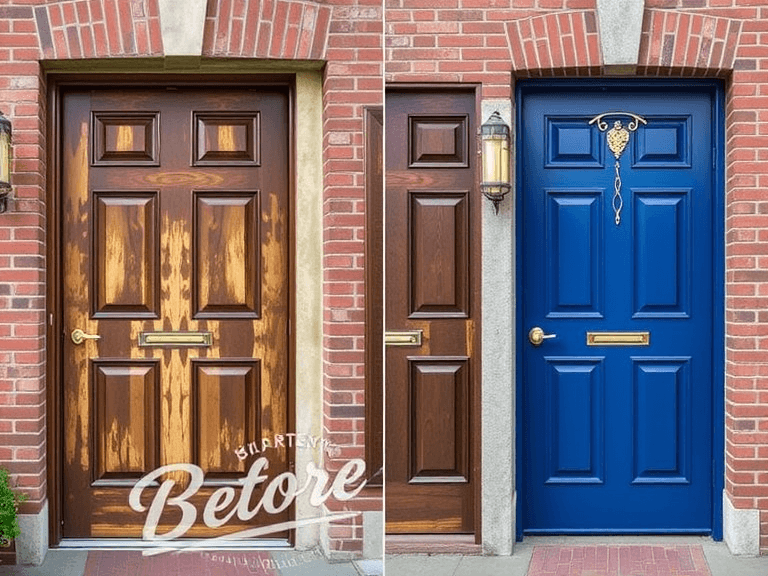Doors are not just functional elements of your home; they are also an integral part of its aesthetic appeal and security. Over time, however, doors can succumb to wear and tear, leaving them looking dull or functioning poorly. Whether it’s your front door, interior doors, or even a garage door, restoring them can breathe new life into your home while saving money compared to a full replacement.
At ZZ the HandyMan, we understand the art and science of door restoration. Let’s delve into why door restoration is important, the steps involved, and tips for maintaining your restored doors.
Why Restore Your Doors?
- Cost-Effective Solution: Replacing doors can be expensive, especially if they are custom-made or feature intricate designs. Restoration, on the other hand, allows you to retain the original door while enhancing its functionality and appearance.
- Preservation of Character: If you own an older home, the doors may be unique and impossible to replicate. Restoring them helps maintain the historical charm and authenticity of your property.
- Eco-Friendly Choice: Door restoration minimizes waste by reducing the need for new materials, making it a sustainable option.
- Increased Home Value: Well-maintained doors contribute to a home’s curb appeal and overall value. Restored doors can make a striking first impression on visitors or potential buyers.
Common Door Issues That Require Restoration
- Peeling Paint or Varnish: Exposure to weather elements can cause paint to chip and wood to dry out.
- Sticking or Misaligned Doors: Shifting foundations or changes in humidity can make doors hard to open or close.
- Squeaky Hinges: Over time, hinges can become noisy due to lack of lubrication or rust.
- Drafts and Gaps: Doors that don’t fit properly can let in drafts, increasing your energy bills.
- Damaged Panels or Frames: Cracks, dents, or scratches can detract from a door’s appearance and functionality.
Steps to Restore a Door
1. Assess the Condition
Begin by inspecting the door for damage. Look for scratches, warping, peeling paint, or signs of rot. Note whether the hardware, such as hinges and handles, needs repair or replacement.
2. Remove the Door
For thorough restoration, remove the door from its frame. Use a screwdriver to detach the hinges and place the door on a flat, stable surface for easier handling.
3. Strip Old Paint or Finish
Use a paint stripper or sandpaper to remove old paint, varnish, or stain. Be sure to wear protective gear, as some older finishes may contain lead. For intricate designs, use a smaller sanding tool or chemical stripper for precision.
4. Repair Damages
Fill cracks, holes, or dents with wood filler. For larger damages, you may need to replace sections of wood or reinforce the door with epoxy. Sand the repaired areas until smooth.
5. Sand the Surface
After removing the old finish and repairing damages, sand the entire surface to ensure a smooth, even base for the new finish. Start with coarse-grit sandpaper and gradually move to finer grits.
6. Refinish the Door
Choose a finish that suits your style and the door’s location. For exterior doors, opt for weather-resistant paints or stains. Interior doors can be finished with stains, varnishes, or enamel paints. Apply the finish in thin, even coats, allowing adequate drying time between applications.
7. Update Hardware
Replace old or tarnished hardware with new pieces to complement the restored door. Ensure the new hardware matches the overall design of your home.
8. Reinstall the Door
Once the finish has dried and the hardware is attached, rehang the door on its frame. Test it to ensure it opens and closes smoothly.
Maintaining Your Restored Doors
- Regular Cleaning: Dust and clean your doors regularly to prevent buildup that can dull their appearance.
- Lubricate Hinges: Apply lubricant to hinges every few months to keep them quiet and functional.
- Inspect for Damage: Periodically check for signs of wear, such as peeling paint or loose hardware, and address them promptly.
- Protect from Weather: For exterior doors, use weather stripping and sealants to guard against moisture and temperature fluctuations.
- Reapply Finish: Depending on the finish and usage, you may need to reapply paint or varnish every few years to maintain the door’s look and durability.
DIY or Professional Help?
While minor restoration tasks can be tackled as DIY projects, more extensive repairs or refinishing may require professional expertise. At ZZ the HandyMan, we specialize in restoring doors of all types and conditions. Our skilled team ensures that every door we work on is both beautiful and functional.
Transform Your Home with Restored Doors
In many cases, the cost of labor to restore exceeds the cost of labor to install a new door. You may want to weigh your options. Please call ZZ the HandyMan to discuss.
Door restoration is an investment in your home’s beauty, functionality, and value. Whether it’s a weather-worn front door or a misaligned interior door, restoring it can bring back its original charm and utility. If you’re ready to give your doors a second chance, contact ZZ the HandyMan today. Let us help you restore the heart of your home, one door at a time.


